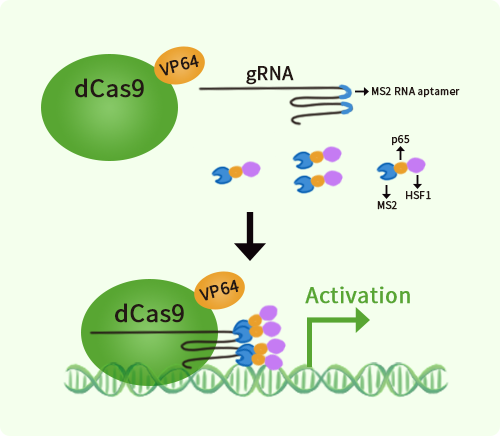Human LRP2 activation kit by CRISPRa
CAT#: GA102733
LRP2 CRISPRa kit - CRISPR gene activation of human LDL receptor related protein 2
Find the corresponding CRISPRi Inhibitor Kit
USD 1,290.00
2 Weeks*
Specifications
| Product Data | |
| Format | 3gRNAs, 1 scramble ctrl and 1 enhancer vector |
| Symbol | LRP2 |
| Locus ID | 4036 |
| Kit Components | GA102733G1, LRP2 gRNA vector 1 in pCas-Guide-GFP-CRISPRa GA102733G2, LRP2 gRNA vector 2 in pCas-Guide-GFP-CRISPRa GA102733G3, LRP2 gRNA vector 3 in pCas-Guide-GFP-CRISPRa 1 CRISPRa-Enhancer vector, SKU GE100056 1 CRISPRa scramble vector, SKU GE100077 |
| Disclaimer | The kit is designed based on the best knowledge of CRISPa SAM technology. The efficiency of the activation can be affected by many factors, including nucleosome occupancy status, chromatin structure and the gene expression level of the target, etc. |
| Reference Data | |
| RefSeq | NM_004525 |
| Synonyms | DBS; GP330 |
| Summary | 'The protein encoded by this gene, low density lipoprotein-related protein 2 (LRP2) or megalin, is a multi-ligand endocytic receptor that is expressed in many different tissues but primarily in absorptive epithilial tissues such as the kidney. This glycoprotein has a large amino-terminal extracellular domain, a single transmembrane domain, and a short carboxy-terminal cytoplasmic tail. The extracellular ligand-binding-domains bind diverse macromolecules including albumin, apolipoproteins B and E, and lipoprotein lipase. The LRP2 protein is critical for the reuptake of numerous ligands, including lipoproteins, sterols, vitamin-binding proteins, and hormones. This protein also has a role in cell-signaling; extracellular ligands include parathyroid horomones and the morphogen sonic hedgehog while cytosolic ligands include MAP kinase scaffold proteins and JNK interacting proteins. Recycling of this membrane receptor is regulated by phosphorylation of its cytoplasmic domain. Mutations in this gene cause Donnai-Barrow syndrome (DBS) and facio-oculoacoustico-renal syndrome (FOAR).[provided by RefSeq, Aug 2009]' |
Documents
| Product Manuals |
| FAQs |
Resources
Other Versions
| SKU | Description | Size | Price |
|---|---|---|---|
| KN213707 | LRP2 - human gene knockout kit via CRISPR, HDR mediated |
USD 1,290.00 |
|
| KN213707BN | LRP2 - human gene knockout kit via CRISPR, HDR mediated |
USD 1,290.00 |
|
| KN213707LP | LRP2 - human gene knockout kit via CRISPR, HDR mediated |
USD 1,290.00 |
|
| KN213707RB | LRP2 - human gene knockout kit via CRISPR, HDR mediated |
USD 1,290.00 |
|
| KN413707 | LRP2 - KN2.0, Human gene knockout kit via CRISPR, non-homology mediated. |
USD 1,290.00 |
{0} Product Review(s)
Be the first one to submit a review






























































































































































































































































 Germany
Germany
 Japan
Japan
 United Kingdom
United Kingdom
 China
China
